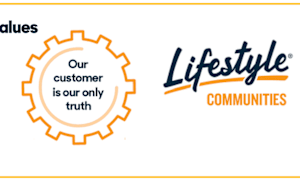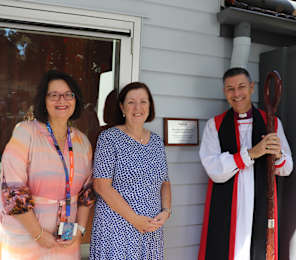Dr Veronique Boscart (pictured above) has told the Commissioners that providers need to take a step back from focusing on ‘care’ to focusing on their staff as a team – and encouraging their personal and professional development – in order to achieve better care outcomes.
For just over an hour, Dr Boscart – a Belgian-born gerontological nurse by training who has lived in Canada for 20 years (and worked as a personal care worker while her visa was finalised) – discussed her experience in staff training and development through her roles as the National Research Chair on workforce and capacity building in the seniors sector at Canada’s National Institute of Research and Science, the Executive of the School of Health and Life Sciences at Conestoga College in Ontario, which has around 40,000 students and the Director of the Schlegel Centre for Advancing Senior Care, a research centre at the College.
Dr Boscart was clearly meant to provide the Commissioners with a case study of how staff training and development can be ‘done right’.
The Centre is a partnership between the College, the University of Waterloo and aged care and retirement living provider Schlegel Villages – which Commissioner Lynelle Briggs visited earlier this year – which has 9,000 residents and 7,000 staff across 23 ‘villages’ under a neighbourhood model where residents live together in ‘neighbourhoods’ of 32 residents with a dedicated team of carers.
Dr Boscart says this ‘team’ model has proved effective because staff are deeply involved in the quality of care delivery and are encouraged to play to their strengths, for example, spending one-on-time with residents or organising events.
Residents and their families are also involved in the hiring of new staff members.
“They know what is really needed on the team and they also know who will be a good fit for the team,” she told Senior Counsel Assisting Peter Rozen QC.
The Centre also provides a ‘hotbed’ for new innovations that can be rolled out across the villages with an annual innovation summit where the villages can present their different research projects and adopt each other’s ideas.
Dr Boscart gave the example of a project that evolved three years ago when there was a high transfer of residents to hospitals. Examining the data, the Centre realised that many of the residents suffered from heart failure.
Working with the teams on how they could pick up failures before it led to hospitalization, it was discovered that while the nursing aides recognised the signs of heart failure, there wasn’t a good documentation system for them to alert the Registered Nurse and GP.
A new system was implemented and rates of admissions dropped – now the project has been implemented across a number of the villages with some of the nursing aides presenting the findings at a cardiology conference last year.
“Nothing can drive engagement and being very proud of what you can do for a nursing aide than actually standing in front of a whole auditorium of cardiologists saying this is amazing,” she said. “So those people run with that. So as a research project with a little bit of guide .... and people can just take it all and fly with it.”
The Centre has also pioneered ‘Living Classrooms’ (pictured below and see a video about the program here) where new nursing aides are trained in the villages to address an issue that operators in Australia will be familiar with – the mismatch between the kind of people that Schlegel wanted in their workforce and the people that were attracted to the work, mainly new migrants with English as a second language.
“People traditionally attracted to these nursing assistant positions might not always have a good experience in a school environment so we wanted to make sure that we could provide education in which there was immediate relevance and application to the work field they were going to go into,” Dr Boscart explained.
The integrated teaching model involves students being taught by team members from the village – with participation from the residents – and observing how the neighbourhoods work before they formally start working in the village – and it has worked.
From 12 students in 2009, the Centre has moved onto larger groups and nurses training and are now set to enrolled their first bachelor degree of nursing intake in 2021 – with graduates offered jobs in the villages or by other providers before they graduate and high retention rates.
Dr Boscart says their success lies in identifying what matters most to nursing aides: that they can make a difference in people’s lives.
“We know that the work circumstances are not always ideal. The pay at times is not great and having worked as a nursing assistant myself, it’s not great and often I have to have two jobs in order to, at the time to meet the needs of my family,” she said.
“So, we try inform our nursing assistants not talk about a job but talk about a career… They can, depending on where they want to go, they can take a long course or they can participate in training of students or different components. In some organisations some of our nursing assistants have gone all the way up to becoming the general manager or assistant director of care in certain environments there are certainly a lot of assistants that are in charge of a neighbourhood not at a clinical level but at a team level.”
Interestingly, Canada does not have the same minimum staffing requirements as the US – the model held up in the Royal Commission’s first research paper on staffing levels.
Instead, there is a minimum standard of time that is set across the residents as a group and adjusted based on the complexity of residents (for 32 residents, Dr Boscart said they would have four to five carers plus an RN and two enrolled nurses).
“We do not have any more government funding than any other nursing home in Canada nor do we have better rates we just try to really look at how best to optimise the team as opposed to the individual and investment in teams what we have done in our neighbourhood team development and the research around quality is if you invest in a team which is a costly investment for an organisational perspective, this leads to better care, therefore it does lead to better care outcomes,” Dr Boscart concluded.
“So very often when we want to have better care outcomes in relation to quality of the care and safety we focus on the very specific care practice that needs to change, if you would look at falls, for example, if you don’t have a staff team that is going to exemplify that practice you will not get better care outcomes because change in care is not going to happen by one specific group. It needs to be a team approach. So that’s, there is no secret to having good quality care outcomes. The answer is investment in staff. That is really the answer to it.”
The Commissioners clearly valued her input.
Commissioner Lynelle Briggs quizzed her on the different skills sets required in home care settings.
Dr Boscart said there is a need for sharper decision-making and priority setting in home care.
“I agree and I fear that we are not, in this country at least, thinking about that independence of thought and more effective communication to raise these issues publicly,” the Commissioner stated. “Are there examples of that kind of issue in Canada or how do you see it playing out?”
“I think one of the things I’ve seen happen in home care which has made strides towards better home care is a good system to document,” Dr Boscart replied. “What used to happen was there was a binder in the home of the older person and a care worker went in and provided care and wrote down what was important or what was changing or what was happening… so you have that immediate response and validation to a care worker that what they observe is important and then one can act on that.”
Her insights also got the tick of approval from Commissioner Tony Pagone.
“I have got no doubt that a lot of the material that you have shared with us will find its way one way or another into what we ultimately decide,” he said.
Sounds like a thumbs-up.










